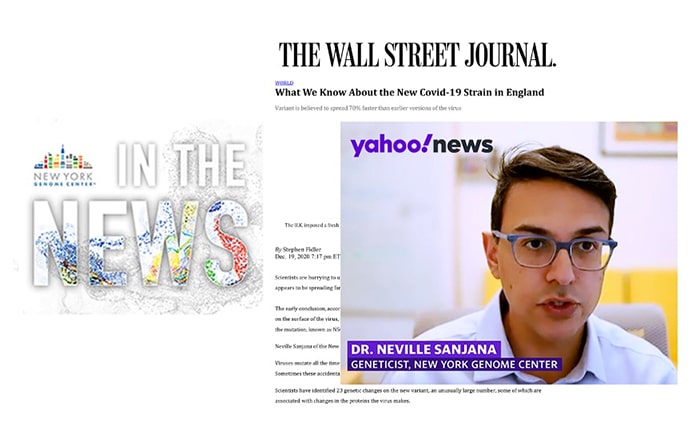The Wall Street Journal and Yahoo! News recently conducted interviews with Neville Sanjana, PhD, Core Faculty Member at the New York Genome Center, Assistant Professor of Biology, New York University, and Assistant Professor of Neuroscience and Physiology, NYU Grossman School of Medicine, to discuss the significance of recent coronavirus variants.
Read these interviews below:
What We Know About the New Covid-19 Strain in England
(The Wall Street Journal, December 19, 2020)
A New Coronavirus Variant Is Spreading in the U.K., but Its Significance Is Unclear
(Yahoo! News, December 17, 2020 – video and article)
“I think there’s really not too much cause for concern, because it’s important to realize that these mRNA [messenger RNA] vaccines don’t actually use one little piece of spike,” said Dr. Sanjana, told Yahoo! News when asked to comment if the new variant could potentially reduce the effectiveness of the current COVID-19 vaccines. “They actually encode the entire spike protein, as RNA, and so this gives your immune system many shots on goal. There are many chances for it to develop a diverse antibody repertoire. So it’s really unlikely that any single mutation in the virus is going to be able to affect antibody responses.”
Dr. Sanjana also noted that most coronavirus variants that have been identified so far have not had a detectable effect on the biology of the virus or led to more severe COVID-19 disease. There is an exception, a mutation of the virus that occurred early in the pandemic, which Dr. Sanjana has studied in his lab. The mutation, known as the D614G or the G variant, made a difference, he says. It occurred on the spike protein, the pointy structure that gives the coronavirus its crownlike profile, and the key that allows it to enter human cells. Although no evidence indicates that the D614G mutation causes more severe symptoms or deaths, research suggests that it makes it easier for the virus to infect cells and spread more easily from person to person. Some scientists believe that this variant, which was first spotted in eastern China in January and then spread quickly throughout Europe and New York City, made the pandemic more difficult to stop.
